Abstract
The animal kingdom, particularly reptiles, is widely recognized as a valuable source of peptides and proteins with applications in medicine, the pharmaceutical industry and, more recently, the cosmetic industry. This prompted an investigation into the prevalence of cosmetic products utilizing synthetic peptides, with a specific focus on viper venom. A major objective of our study was a comparative analysis between natural venom-derived peptides and synthetic analogues, which could provide valuable insights into the market impact. The identification and inclusion of these products were based on their listings according to the International Nomenclature of Cosmetic Ingredients (INCI), alongside a review of the current literature and the recognition of relevant studies aimed at evaluating the composition of viper venom. Additionally, cosmetics were identified through online media using specific keywords such as “viper venom”, “snake venom”, “snake”, “SYN®-AKE”, “analogues of snake venom” or “synthetic snake venom”, followed by a comparative analysis of the products identified. The study provided an extensive background considering the market segmentation of viper venom-based and synthetic peptide-based cosmetics, including 245 cosmetics (70 manufacturers), also including the classification into Mass-Market and Premium-Market segments, which adds practical value. In 81% of the total analyzed products, the synthetic analogue was present, SYN®-AKE (INCI Dipeptide Diaminobutyroyl Benzylamide Diacetate (and) Glycerin (and) Aqua), while 13% contained snake venom or viper venom. The high percentage of cosmetics categorized under the Mass-Market segment could be attributed to the use of synthetic peptides, given the high cost of natural viper venom as an anti-ageing ingredient, a price likely reflected in the final cosmetic product. In terms of product category, skin care cosmetics made up the largest share, followed by body care products, typically claiming anti-ageing and moisturizing properties.
1. Introduction
The animal kingdom represents a precious source for identifying molecules with potential applications in the pharmaceutical industry, medicine and, more recently, in the cosmetics industry, for example, due to the complex composition of venoms [1]. Venomous animals include snakes, spiders, sea snails, scorpions, lizards, jellyfish, sea anemones and cephalopods, possessing permanently or periodically toxic substances in their bodies [2]. Some of these organisms contain toxic compounds in different tissues, while others possess specialized venom glands [3]. Venom is a secretion, produced in a specialized gland in an animal, and it is delivered to a target animal through the infliction of a wound. It contains molecules that interfere with normal physiological or biochemical processes, thereby aiding in feeding or defense mechanisms for the producing animal [2,4,5,6].
Over time, animal venoms—particularly those from snakes, scorpions and lizards—have proven to be remarkable models for understanding many fundamental processes in medicine, also contributing to the development of pharmaceutically active substances with therapeutic effects, still used nowadays (for e.g., Captopril—Bothrops jararaca (Brazilian pit viper or traditionally known as jararaca), Eptifibatide—Sistrurus miliarus barbouri (with the common name Florida ground rattlesnake or Dusly Pygmy Rattlesnake)). In cosmetology, the use of venom represents an innovative field due to the development of neurocosmetics and an increased demand for cosmetic products. Thus, cosmetics based on certain peptides from snake venom, such as neurotoxins, prevent the appearance of fine lines and wrinkles [7].
Proteins and peptides from snake venom with neurotoxic properties, such as phospholipase A2 [8,9,10,11], protease inhibitors [12,13,14,15], three-finger toxins [9], nerve growth factor [16] and waglerin [17,18,19,20,21], could be utilized for their anti-ageing effects or for the development of innovative active ingredients with similar benefits. The primary advantages of these peptides include high target specificity, safety and low toxicity [7].
In addition to their anti-ageing properties, snake venom peptides have been explored for various other benefits in cosmetic applications like skin firming, antioxidant, moisturizing and skin barrier repair properties, and even for the reduction of periorbital hyperpigmentation [22].
The development of neurocosmetics containing snake venom, and the continuous increase in demand for cosmetic products claiming an anti-ageing effect, led to the development of synthetic peptides sustaining the same effect, but at a more affordable cost compared to pure venom, such as SYN®-AKE (INCI: Dipeptide Diaminobutyroyl Benzylamide Diacetate (and) Glycerin (and) Aqua) (DSM-Firmenich Beauty & Care, Basel, Switzerland) and SYN®-COLL (INCI: Palmitoyl Tripeptide-5 (and) Glycerin (and) Aqua) (DSM-Firmenich Beauty & Care, Basel, Switzerland) [23,24].
The cosmetics industry continuously develops new peptides due to their promising and innovative properties, aligning with the expanding market demand. A wide range of peptides derived synthetically from snake venom, silkworms, etc. are currently available on the market [9].
Considering these aspects, a major objective of this study was to conduct a comparative analysis between natural venom-derived peptides and their synthetic analogues in currently commercially available cosmetic products, aiming to provide valuable insights into their formulation and impact on the market.
2. Peptides—From Snake Venom to the Cosmetic Industry
Among many aspects that contribute to the well-being of consumers, healthy and youthful-looking skin plays a very important role, considering the market growth for skin care products observed in recent years [25].
Ageing is a time-dependent biological process, with its earliest signs gradually appearing as progressive changes in the skin’s morphology and physiology. Skin is the largest organ of the human body, and its functions are various physiological processes, such as thermoregulation, vitamin D production, sensory perception and, most importantly, protection against external factors [7].
As the skin plays a central role in personal identity, consumers increasingly seek solutions to counteract the ageing process, showing a strong preference for anti-ageing cosmetics formulated with innovative active ingredients. The use of bioactive or functional compounds of natural origin remains a prevailing trend. Beyond efficacy, growing environmental awareness is also influencing formulation strategies, with a clear shift toward reducing the reliance on synthetic ingredients in favor of more sustainable alternatives [7].
Natural products are based on derivatives of organisms found in nature, such as algae, plants and animals. These include proteins, peptides, carbohydrates, minerals, antioxidants, essential fatty acids, vitamins or fibers. The different categories of natural anti-ageing ingredients include moisturizers, barrier repair agents, antioxidants, vitamins, hydroxy acids, anti-inflammatory and sunscreen ingredients [7,26].
Peptides are important in many natural processes relevant to skin care, such as modulation of cell proliferation, cell migration, inflammation, angiogenesis, melanogenesis and protein synthesis and regulation, leading to a wide variety of physiological processes, including defense, immunity, homeostasis and reproduction [21,27].
Biomimetic peptides, on the other hand, are compounds that have an amino acid sequence identical to physiological peptides, which are biotechnologically synthesized. They mimic the action of growth factors and cytokines by interacting with their receptors, leading to clinical effects such as preventing the visible signs of skin ageing [28].
Bioactive peptides are also synthetic compounds consisting of modified amino acid chains that improve an already existing physiological function, such as increased skin permeability, stability, solubility and better interaction with cell receptors. Also, several natural physiological processes are modulated by interaction with a specific amino acid sequence found in peptides and protein fragments. Thus, bioactive peptides are becoming increasingly promising in cosmetic products, with clinical applications in various skin conditions [28].
Multiple applications of these synthetic compounds, either biomimetic or bioactive, through topical application, offer treatment options for the prevention or alleviation of the clinical aspects of dysfunctional skin, such as ageing, hyperpigmentation and wrinkle development. They can stimulate collagen and elastin synthesis, enhance wound healing, increase fibroblast proliferation, but also possess antioxidant, antimicrobial and whitening effects [28,29].
Peptides have been used in the cosmetic industry since 1973, when Pickart proposed the synthetic peptide GHK (glycyl-L-histidyl-L-lysine) as a signal peptide that enhances collagen production and acts as a carrier peptide when coupled with Cu (II). However, they did not gain notoriety in cosmetics until the early 2000s, when Palmitoyl Pentapeptide-4 was launched, proposing to reduce facial wrinkles. Since then, due to their versatility, several peptides of cosmeceutical interest have emerged, being developed according to consumer demands [25,30].
Based on their capability to control certain biological functions, nowadays, peptides are one of the latest advanced ingredients that have led to a beauty revolution [31]. A wide variety of peptides is commercially available as active ingredients incorporated into products such as creams, lotions or other topical formulations, which can be classified according to their mechanism of action (Table 1) [25,27,28,30,31,32,33,34,35]. Peptides that inhibit neurotransmitters are used in anti-ageing cosmetics, acting similarly to botulinum toxin, which causes muscle paralysis by blocking the release of acetylcholine at neuromuscular junctions through specific and exclusive endopeptidase activity against the SNAP-25 (Synaptosomal-Associated Protein, 25 kDa) complex. Toxins that bind to acceptor sites on the neuronal membrane are taken up into the cell by a calcium dependent translocation process and cleave specific SNARE proteins (Soluble N-ethylmaleimide-sensitive factor attachment protein receptors) [21,28].
Treatment with botulinum neurotoxin comes with limitations; namely, it must be carried out under medical supervision to limit the occurrence of unwanted reactions. To avoid this limitation, small peptide molecules that mimic the action of Botox are of increasing interest to formulators and compounders. Biomimetic peptides acting similarly to botulinum toxin have been developed and used for this purpose, but in recent years, bioactive peptides extracted from toxins of venomous organisms that disrupt neuromuscular communication have been studied to paralyze prey [28].
The main advantages of peptides are high target affinity, safety in use, the remarkable versatility in interacting with diverse biological structures and low toxicity. On the other hand, low oral bioavailability and poor membrane permeability are considered disadvantages. Initially, peptides were obtained from natural sources such as animal venoms or skin, but due to the high cost of producing final cosmetic products, and with advances in peptide engineering, attention has turned to the development and use of synthetic peptides [31].
Synthetic peptides, such as snake venom peptides, namely Tripeptide-3 (SYN®-AKE) and Pentapeptide-3 (Vialox®), were of interest for this study. SYN®-AKE is a small synthetic peptide that reduces the appearance of wrinkles and expression lines. The concentration recommended by the manufacturer for the onset of the anti-ageing effect is 4%. As the skin ages, the number of expression lines increases. Tripeptide-3 allows the facial muscles to relax, reducing wrinkles, but without inhibiting the ability of muscle contraction [24]. Vialox® is a very powerful anti-wrinkle ingredient. It is found in powder form and acts by reducing muscle cell contraction. It is known as a “botox-like” cosmetic ingredient. Both commercial active ingredients have the advantage of non-invasive application [36].

Table 1.
Category of peptides.
Table 1.
Category of peptides.
| Signal | Carrier | Neurotransmitter Inhibitor | Enzyme Inhibitor | Obtained from the Digestion of Structural Proteins |
|---|---|---|---|---|
| Mechanism of Action | ||||
| Stimulates the production of matrix proteins (collagen and elastin) and cell growth, among other cellular metabolic functions | Facilitates the transport of important substances or trace elements inside the cell, such as copper and magnesium | Prevents the release of acetylcholine at the neuromuscular junction by cleaving the SNARE protein “SNAP-25”, which inhibits signal transduction pathways | Prevents the degradation of collagen and other proteins by inhibiting the activity of the respective enzymes and interfering with the breakdown processes | Improves water-holding capacity, hydration and elasticity of the skin |
| Peptide (INCI name) | ||||
| Acetyl tetrapeptide-9 [37] Acetyl tetrapeptide-11 [38] Cyclotetrapeptide-24 Aminocyclohexane Carboxylate [39] Hexapeptide-10 [40] Hexapeptide-11 [41] Hexapeptide-14 [42] Acetyl sh-Heptapeptide-1 [43] Oligopeptide-68 [44] Nicotiana benthamiana Hexapeptide-40 SH-Oligopeptide-1 [45] Nicotiana benthamiana Hexapeptide-40 SH-Polypeptide-5 [30] Nicotiana benthamiana Hexapeptide-40 SH-Polypeptide-7 [30] Nicotiana benthamiana SH-Polypeptide-45 [30] Tripeptide-3/5 [33] Tripeptide-32 [46] Nicotiana benthamiana SH-Polypeptide-7 [30] Nicotiana benthamiana Hexapeptide-40S H-Polypeptide-9 [30] Nicotiana benthamiana SH-Oligopeptide-2 [30] Nicotiana benthamiana Hexapeptide-40 SH-Polypeptide 2 [30] Nicotiana benthamiana SH-Polypeptide-15 [30] Pentapeptide-34 [28] Palmitoyl pentapeptide-4 [47] Pamlitoyl tripeptide-38 [48] Palmitoyl Tripeptide-1 [49] Palmitoyl tetrapeptide-7/3 [30] Palmitoyl hexapeptide-12 [50] Trifluoroacetyl-tripeptide-2 [51] Tripeptide-10 Citrulline [52] Tripeptide-41 [53] | Copper Tripeptide-1 [54] Manganese tripeptide 1 [55] Diaminopropionoyl Tripeptide-33 [56] Tripeptide-9 Citrulline [57] | Tripeptide-3 [58] Pentapeptide-3 [55] Acetyl Tripeptide-30 Citrulline and Pentapeptide-18 [59] Pentapeptide-18 [27] Acetyl hexapeptide-8 [60] Acetyl Dipeptide-1 Cetyl Ester [61] Acetyl Tetrapeptide-5 [62] Acetyl Octapeptide-3 [63] Acetyl hexapeptide-3 [64] | Silk fibroin peptides [65] Rice peptides [66] Soybean peptides [67] | Keratin-based peptides [68] |
3. Materials and Methods
A methodical and comprehensive search from October 2021 to December 2024, using Google and other commercial platforms presenting cosmetic producers, manufactures or distributors, was performed. The research was also conducted using PubMed—for peer-reviewed articles and clinical studies related to snake venom and cosmetic applications to ensure a comprehensive and scientifically robust study. Additionally, cosmetic ingredient databases (e.g., CosIng and Cosmetic Ingredient Review—CIR) were used to verify regulatory and safety information on cosmetic peptides and related ingredients (Figure 1).
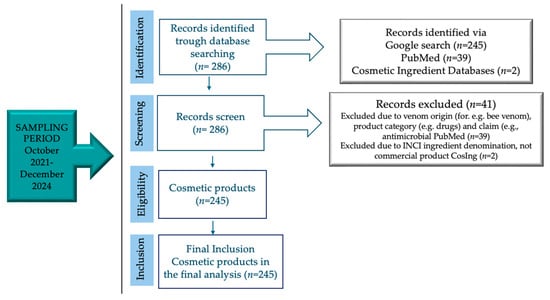
Figure 1.
PRISMA flowchart representing the selection process for commercially available cosmetic products containing viper venom or its synthetic analogue.
To identify cosmetic products that claim snake venom or synthetic peptides (SYN®-AKE) in their composition as active ingredients, based on the trade name, keywords like snake venom, viper venom, viper, snake, SYN−AKE, synthetic snake venom, cosmetic with venom, Temple viper, peptide and cobra venom were used.
The product ingredient lists were examined to identify snake venom or biomimetic peptides like SYN®-AKE (Glycerin, Aqua, Dipeptide Diaminobutyroyl Benzylamide Diacetate) (DSM-Firmenich Beauty & Care, Basel, Switzerland) according to the International Nomenclature of Cosmetic Ingredients (INCI) denomination. Data were analyzed with respect to the diverse parameters.
According to the global market, following the recognition of cosmetic products claiming snake venom or SYN®-AKE as an active ingredient, their brands and origins were identified. In addition, the products were classified according to their price into Mass-Market (products with an affordable price) or Premium-Market (cosmetics characterized by a higher purchasing price).
Cosmetic companies categorize their products into three main segments based on price: (i) premium products, (ii) Mass-Premium products and (iii) Mass-Market products. Pricing plays a crucial psychological role in consumer perception, as higher prices are often associated with superior quality and exclusivity [69]. Premium cosmetics are typically positioned at the higher end of the market, commanding a greater purchase price, whereas Mass-Market products are generally more affordable and widely accessible [70,71].
Considering the active ingredient, the International Nomenclature of Cosmetic Ingredients (INCI) list was searched for each cosmetic product for the presence of snake venom or similar biomimetic peptides, in particular SYN®-AKE.
According to the cosmetic product category and claimed effects, products were classified considering their application area and the cosmetic benefits.
Following these criteria, 245 cosmetic products were selected (Supplementary Material). These were commercially available globally in the online environment, corresponding to both the Mass-Market and the Premium-Market.
4. Results and Discussion
4.1. Consideration on the Global Cosmetics Market
People no longer use cosmetics as a luxury but as a necessity. Nowadays, cosmetics are no longer used only to beautify or camouflage certain defects, but by adding new active ingredients, obtained from natural sources or through the latest generation of biotechnologies, they can improve various skin conditions, such as psoriasis, diverse types of dermatitis or other skin conditions, even those caused by radio- and chemotherapy.
The global cosmetics market is experiencing robust and consistent growth, driven by increasing consumer demand for beauty and skincare products. In 2022, the global market was valued at USD 262 billion, and it is projected to expand at a compound annual growth rate (CAGR) of 4.2% until 2030 [72]. This growth is fueled in part by the rising preference for natural and organic cosmetics, which is anticipated to reach a market size of over USD 33 billion by 2027, thriving at a healthy CAGR of 9.76% during the forecast period. The skin and beauty products sector, in particular, is gaining momentum globally. In 2021, this segment alone recorded a turnover exceeding USD 80 billion. The United States leads the consumption of cosmetics, followed by Asian markets, notably China, Japan and India, which together account for an average expenditure of over USD 35 billion. In Europe, the largest markets are the UK, Germany and France, further underscoring the widespread and expanding demand across multiple regions.
This dynamic market landscape reflects evolving consumer preferences, particularly toward multifunctional, sustainable and organic beauty products, as well as increased awareness of skincare and anti-aging solutions worldwide [73].
These turnovers are shared by thousands of manufacturers worldwide. In our analysis, we identified 105 manufacturers producing and marketing cosmetics claiming snake venom or the synthetic peptide, SYN®-AKE. In terms of their global distribution, they were found in 24 countries on four continents (USA, Asia, Europe and Africa), but the majority were present in European countries (Figure 2).
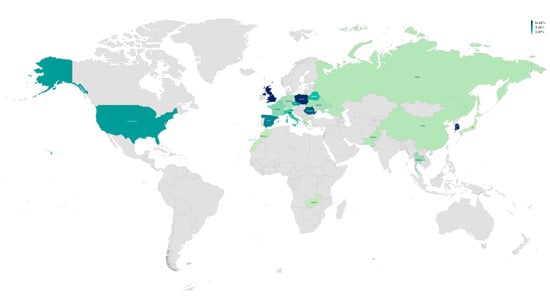
Figure 2.
Global cosmetic market claiming snake venom or similar biomimetic peptides.
Producers (n = 70) from the UK, Poland, Romania, Belarus, Spain, Czech Republic and 11 other European countries have the most cosmetics claiming snake venom or biomimetic peptides as active ingredients, at 72.65%, representing 178 of the products analyzed. Asian manufacturers in South Korea, China, Japan, Thailand, Pakistan and Israel market 48 of the products analyzed (19.59%) for ageing skin, while American and African producers account for 19 of the cosmetics.
Even though most venomous snake species are present in the tropical and subtropical zones, like India, the Malay Archipelago, Central America, Brazil, the southern United States and some parts of Africa, most of the cosmetics analyzed are from the United Kingdom (37 products—16.44%), Poland (35 products—15.56%), Romania (27 products—12%) and Spain (21 products—9.33%) (Europe), as well as South Korea (35 products—15.56%). These countries have an average of 10 local manufacturers marketing snake venom or SYN®-AKE in cosmetic formulations.
By analyzing the Mass-Market and Premium-Market categories, we noticed that more than 80% of the cosmetics we selected belong to the Mass-Market category. As we see in Figure 3, brands from 21 countries on all four continents mentioned above produce and commercialize cosmetics at reduced prices, making them accessible to a wider population. Poland, Romania, Spain, the Czech Republic in Europe and South Korea in Asia are the countries that, besides having the most selected products on the market, also present the most cosmetics in the Mass-Market category. This may be due to the presence of venomous snakes, especially vipers, from which venom can be used in cosmetic products. On the other hand, the elderly populations of these and neighboring countries may be the reason why the increased demand for anti-ageing products stimulates manufactures to maintain a final cost of cosmetics that is affordable for all social categories.
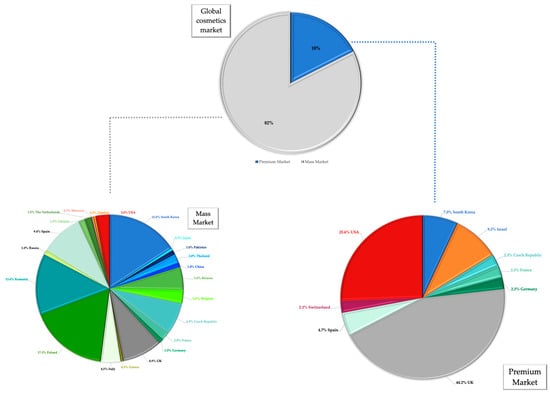
Figure 3.
Mass-Market and Premium-Market product category of selected cosmetics.
However, brands from nine countries in the US, Europe (the UK, the Czech Republic, Spain, Switzerland, Germany, France) and Asia (Israel, South Korea), in addition to Mass-Market products, also sell Premium products, claiming a higher amount of active ingredient, considering snake venom or biomimetic peptides as actives.
4.2. Active Ingredient
In the cosmetic industry, snake venom, more precisely viper venom, is used due to the high number of neurotoxins compared to other snake families, and for its Botulinum toxin-like effect. It blocks the release of the neurotransmitter acetylcholine at the neuromuscular junction, causing partial muscle paralysis, thus preventing the appearance of wrinkles and their fading [74].
Snake venom has many benefits in the medical/pharmaceutical field as well as in the cosmetic industry. However, the main drawback is the very high cost per gram of venom (hundreds to thousands of euros). The high price is due to the small amount of venom secreted by each snake and the decrease in the number of snakes in recent years in the fauna because of adverse climatic conditions. The number of certified biobanks has also decreased.
Thus, with the advanced technologies of recent years and increased interest in innovative active ingredients, biomimetic peptides have emerged.
SYN®-AKE (Tripeptide-3) is a bioactive peptide designed as a powerful anti-wrinkle agent, mimicking Waglerin-1, which is naturally found in the venom of Tropidolaemus wagleri and acting synergistically with the skin’s natural processes to minimize the appearance of wrinkles and fine lines. By promoting facial relaxation, it helps reduce wrinkles while preserving natural facial expressions [75,76].
The correct identification of the ingredients of each product was performed using information from the product packaging according to the INCI list. INCI (International Nomenclature of Cosmetic Ingredients) names are used in the European Union, China, Japan, the United States and other countries for listing ingredients on cosmetic product labels. These denominations are similar in all countries, with a few exceptions [77].
Based on an analysis of globally commercially available products that claim to contain snake venom or Tripeptide-3 according to their trade names, we evaluated the product effect on the ingredient lists, as specified by the INCI denomination. Our findings revealed that references to snake venom appear under various keywords—such as “snake venom”, “snake”, “viper venom”, “viper”, “cobra venom”, “venom” and “Temple viper”—in over 63% of cases, corresponding to 155 commercially available cosmetic products (Figure 4).
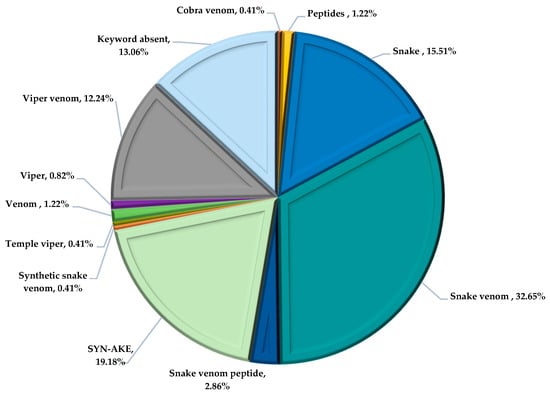
Figure 4.
Cosmetics identified by keywords according to their trade names.
SYN®-AKE was found in only 19% of the analyzed products, with a reduced percentage (1–3%) containing claims of other venom-like peptides. However, a detailed review of the INCI ingredients lists on the product packaging, revealed that the synthetic peptide SYN®-AKE (INCI: Glycerin, Aqua, Dipeptide Diaminobutyroyl Benzylamide Diacetate) was present in 81% of the products (199 products), compared to only 13% featuring snake or viper venom (Figure 5).
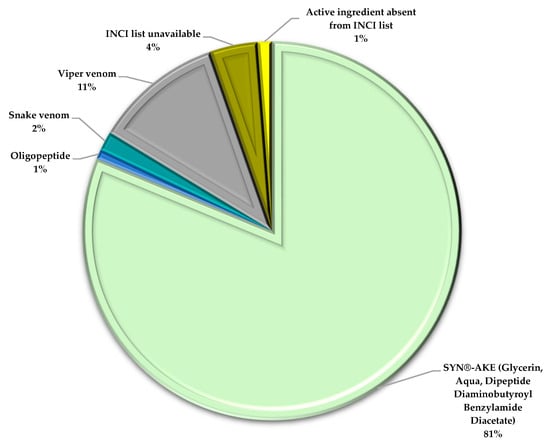
Figure 5.
Active ingredients according to the INCI list of commercially available cosmetics.
In the case of three analyzed products, the absence of snake venom and snake-like peptides was observed. Additionally, for ten products claiming one of the keywords searched according to the trade name, it was not possible to identify the list of ingredients.
Considering the discrepancy between the large number of products claiming snake venom according to their trade name (155 cosmetics) and the small number containing it according to the INCI list, we performed another statistical analysis (Figure 6). Of the 155 cosmetics that claim snake or viper venom according to their trade name, only 30 (20%) of them incorporate venom. Most of the commercially available products incorporate the synthetic peptide, SYN®-AKE (72%).
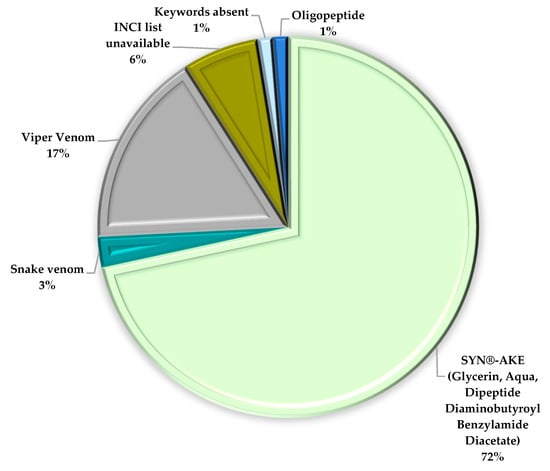
Figure 6.
Active ingredients in commercial cosmetics claiming snake venom (n = 155).
4.3. Cosmetic Product Category and Claimed Effects
By analyzing recent global statistics and the market for selected products, we found that the anti-ageing effect is the most claimed benefit, featured in 178 products (73%), followed by moisturizing properties in 40 products (16%) (Figure 7).
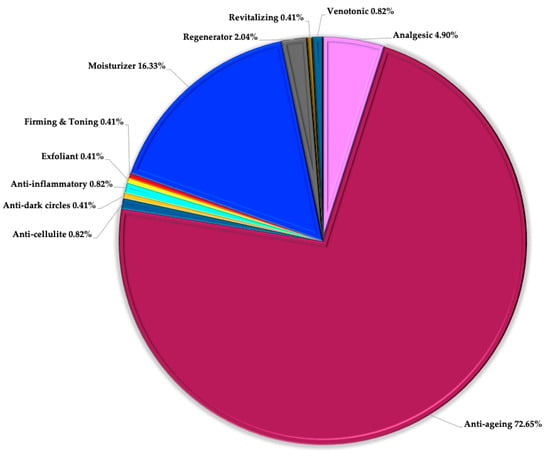
Figure 7.
Claimed effects of examined commercial products.
Anti-ageing cosmetics play an important role in an individual’s life by first providing skin health but also glow and moisturization to the skin. Various factors such as alcohol consumption, tobacco or a generally unhealthy lifestyle are primarily responsible for skin ageing and other skin-related abnormalities. These considerations create the need for innovative, safe and effective cosmetics. Product diversification, adoption of a customer-centric approach and technological innovation together with marketing and branding effectiveness are some of the important factors for companies operating in the anti-ageing cosmetics sector [78,79,80].
The abundance of products claiming anti-ageing effects can be correlated with the predominant number of commercially available cosmetic formulations incorporating SYN®-AKE, a synthetic peptide known and used for improving fine wrinkles and ameliorating skin ageing signs. Additionally, in the cosmetic industry, snake venom is known for its lifting effect, as it improves wrinkles and expression lines due to its botulinum toxin-like effect.
Personal care products and cosmetics are used on the human body to cleanse, beautify or change its appearance. Thus, they have been classified by the area of application into products for body care, skincare, hair care and oral care.
Following this classification, skincare products increasingly incorporate the synthesized active ingredient SYN®-AKE or snake venom (n = 211—86.5%) in formulations such as emulsions (face creams, eye creams, eye gel, face gel) (n = 114), serums (n = 64), facial masks (n = 23), eye pads (n = 5) or toners (n = 4). Twenty-nine body care products, namely, emulsions, bath salts and body serums, were identified (Figure 8).
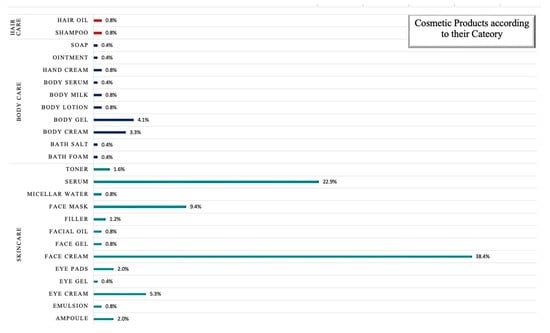
Figure 8.
Cosmetic products claiming viper venom versus synthetic peptides according to their category and area of application.
Although the predominant claimed effects were anti-ageing and moisturizing cosmetic properties, regenerative and revitalizing effects were stated in the case of hair care cosmetics (n = 4).
Considering this classification, skincare products are the most popular, being used daily by millions of consumers to improve the appearance and feel of skin. These can be classified as leave-on and/or rinse-off products.
In the category of leave-on products, moisturizing products are designed to improve skin feel and appearance, anti-ageing products improve aged skin signs and symptoms, and formulations containing UV filters are recommended for sun protection.
On the other hand, cleansers like facial washes, toners, hand soaps or body washes can be classified as rinse-off cosmetics. This category also includes exfoliation products, masks and scrubs.
According to the formulation type, the identified skincare products are predominantly emulsions, claiming anti-ageing effect (32.6%), followed by serums with the same claimed effect (21.6%) (Figure 9). As previously mentioned, snake venom shows an anti-wrinkle effect due to the presence of compounds with neurotoxic effects, such as phospholipase A2, nerve growth factor, three-finger toxins, etc.

Figure 9.
Claimed effects of skincare products incorporating viper vein or its synthetic analogue.
The moisturizing effect follows immediately after the anti-ageing effect, mainly in emulsions such as facial creams and gels or creams designed for the periorbital area. The hydrating effect is not only due to the presence of active ingredients in cosmetic formulations, but also to emollients and other auxiliary substances (humectants, occlusive agents, etc.). Emollients are ingredients which, when added to cosmetic formulations, increase the moisture content of the skin by reducing water evaporation, providing a smooth, soft and non-greasy skin feel. Among the most used emollients in cosmetic formulations are natural oils such as jojoba oil, cocoa butter or mineral oils [81,82,83]. Occlusive agents also possess the ability to decrease transepidermal water loss (TEWL) because they coat the stratum corneum. In addition, when applied to the skin’s surface, humectants attract moisture both from the air and from the deeper layers of the stratum corneum to the surface [71,84].
While skincare products frequently claim anti-ageing and moisturizing effects, when considering body care products such as body gel, body cream or body milk, an analgesic effect is claimed, followed by moisturizing and anti-cellulite properties (Figure 10).
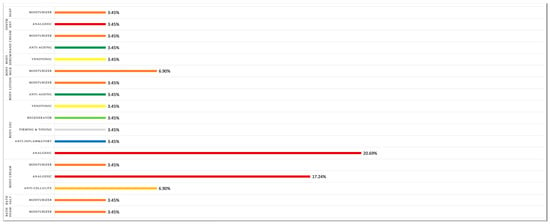
Figure 10.
Claimed effects of body care products. Moisturizing (n = 8) and anti-ageing (n = 2) effects are also claimed in body cosmetics, in both rinse-off and leave-on formulations (e.g., body lotion, body milk, hand cream) (Figure 9). Moreover, anti-cellulite (n = 2), venotonic (n = 2), analgesic (n = 12) and anti-inflammatory (n = 1) effects have been highlighted due to the presence of snake venom or synthetic peptides, SYN®-AKE and other active ingredients of natural origin, such as plant extracts (Salvia officinalis, Salix alba, Panax ginseng, Salvia rosmarinus, Harpagophytum procumbens).
5. Conclusions
Snake venom is primarily composed of proteins and peptides (90–95%), with trace amounts of metal ions, lipids and carbohydrates. In medicine and in the pharmaceutical industry, venom-derived proteins have led to the development of active substances, such as captopril, enalapril, tirofiban, eptifibatide and batroxobin, with proven therapeutic properties, including antiplatelet, antihypertensive and analgesic effects. These proteins are also used for diagnostic purposes to assess factors like antithrombin activity and fibrinogen levels. In cosmetics, snake venom peptides are utilized for their neurotoxic effects, reducing wrinkle depth and length, thus providing anti-ageing properties. Additionally, these peptides contribute to moisturizing effects, enhancing the skin’s hydration. In the cosmetic industry, peptides are used for their neurotoxic effects, acting at the neuromuscular junction, thus reducing the wrinkle length and depth. Thus, the claimed effect of snake venom in cosmetics is its anti-ageing effect. These are not the only properties for which snake venom or synthetic peptides are used in cosmetics; they are also used for their moisturizing effect.
The selected cosmetic products in this study are produced by 105 cosmetic companies, found in 24 countries in Europe, Asia, the USA and Africa. Most manufacturers are based in European countries (n = 70) and produce almost three quarters of the analyzed products (n = 178). Considering 245 commercially available cosmetics claiming snake venom or viper venom in their composition, it was noticed that 31 incorporate snake or viper venom based on the product packaging INCI list, while other formulations contain the active ingredient SYN®-AKE, a synthetic peptide similar to snake proteins claiming various concentrations in the range from 0.01 to 4% in the final product.
Venom of natural origin has a very high cost compared to other active ingredients claiming anti-ageing effects and, due to this consideration several manufacturers utilize various chemically synthesized peptides with similar properties, such as SYN®-AKE (Tripeptide), at a lower cost. Mass-Market cosmetics predominantly incorporate synthetic peptides instead of natural viper venom due to cost considerations. The extraction and purification of natural viper venom is complex and expensive, significantly increasing the final product’s price. Synthetic alternatives, such as SYN-AKE®, replicate the effects of viper venin at a lower production cost, making them a more viable and affordable option for Mass-Market brands. Considering the cosmetic product category, skin care products represent the largest share (n = 211), claiming primarily anti-ageing and moisturizing benefits, followed by body care (n = 29), possessing regenerating and revitalizing properties.
The study’s findings emphasize the increasing significance of snake venom and synthetic peptides in cosmeceuticals, particularly considering their anti-aging properties. A more in-depth investigation of the clinical evidence supporting these innovative ingredients and cosmetic formulations could provide greater insight into their effectiveness. Critical challenges remain related to efficacy and safety validation, together with regulatory compliance. Addressing these issues through future research and innovation could enhance the safety, efficacy and transparency of these active ingredients, ultimately shaping the next generation of cosmetic products. Future research could also focus on performing comparative clinical trials to evaluate the efficacy of natural viper venom versus synthetic peptides, which could help to demonstrate whether premium cosmetics truly offer superior benefits compared to mass-market alternatives.
Supplementary Materials
The following supporting information can be downloaded at: https://www.mdpi.com/article/10.3390/app15084501/s1, Table S1: Cosmetic products claiming snake venom or biomimetic peptides as active ingredients.
Author Contributions
Conceptualization, D.G.M., A.M.J., L.-L.R. and F.G.G.; methodology, D.G.M., A.M.J., L.-L.R. and G.C.; software, D.G.M. and L.-L.R.; resources, D.G.M., A.M.J., L.-L.R. and A.L.V.-Ț.; writing—original draft preparation, D.G.M., A.M.J., L.-L.R. and A.L.V.-Ț.; writing—review and editing, D.G.M., A.M.J., L.-L.R. and G.C.; visualization, D.G.M., A.M.J., G.C. and F.G.G.; supervision, F.G.G. and A.M.J.; project administration, D.G.M. and A.M.J. All authors have read and agreed to the published version of the manuscript.
Funding
This research received no external funding.
Institutional Review Board Statement
Not applicable.
Informed Consent Statement
Not applicable.
Data Availability Statement
The original contributions presented in the study are included in the article/Supplementary Material, further inquiries can be directed to the corresponding author.
Conflicts of Interest
The authors declare no conflicts of interest.
References
- Munawar, A.; Ali, S.A.; Akrem, A.; Betzel, C. Snake Venom Peptides: Tools of Biodiscovery. Toxins 2018, 10, 474. [Google Scholar] [CrossRef] [PubMed]
- Fry, B.G.; Roelants, K.; Champagne, D.E.; Scheib, H.; Tyndall, J.D.A.; King, G.F.; Nevalainen, T.J.; Norman, J.A.; Lewis, R.J.; Norton, R.S.; et al. The Toxicogenomic Multiverse: Convergent Recruitment of Proteins into Animal Venoms. Annu. Rev. Genomics Hum. Genet. 2009, 10, 483–511. [Google Scholar] [CrossRef] [PubMed]
- Utkin, Y.N. Animal Venom Studies: Current Benefits and Future Developments. World J. Biol. Chem. 2015, 6, 28–33. [Google Scholar] [CrossRef] [PubMed]
- Casewell, N.R.; Wüster, W.; Vonk, F.J.; Harrison, R.A.; Fry, B.G. Complex Cocktails: The Evolutionary Novelty of Venoms. Trends Ecol. Evol. 2013, 28, 219–229. [Google Scholar] [CrossRef]
- Fry, B.G.; Casewell, N.R.; Wüster, W.; Vidal, N.; Young, B.; Jackson, T.N.W. The Structural and Functional Diversification of the Toxicofera Reptile Venom System. Toxicon 2012, 60, 434–448. [Google Scholar] [CrossRef]
- Casewell, N.R.; Jackson, T.N.W.; Laustsen, A.H.; Sunagar, K. Causes and Consequences of Snake Venom Variation. Trends Pharmacol. Sci. 2020, 41, 570–581. [Google Scholar] [CrossRef]
- Ahmed, I.A.; Mikail, M.A.; Zamakshshari, N.; Abdullah, A.S.H. Natural Anti-Aging Skincare: Role and Potential. Biogerontology 2020, 21, 293–310. [Google Scholar] [CrossRef]
- El-Aziz, T.M.A.; Soares, A.G.; Stockand, J.D. Snake Venoms in Drug Discovery: Valuable Therapeutic Tools for Life Saving. Toxins 2019, 11, 564. [Google Scholar] [CrossRef]
- Ferraz, C.R.; Arrahman, A.; Xie, C.; Casewell, N.R.; Lewis, R.J.; Kool, J.; Cardoso, F.C. Multifunctional Toxins in Snake Venoms and Therapeutic Implications: From Pain to Hemorrhage and Necrosis. Front. Ecol. Evol. 2019, 7, 218. [Google Scholar] [CrossRef]
- Still, K.B.M.; Slagboom, J.; Kidwai, S.; Xie, C.; Zhao, Y.; Eisses, B.; Jiang, Z.; Vonk, F.J.; Somsen, G.W.; Casewell, N.R.; et al. Development of High-Throughput Screening Assays for Profiling Snake Venom Phospholipase A2 Activity after Chromatographic Fractionation. Toxicon 2020, 184, 28–38. [Google Scholar] [CrossRef]
- Ojeda, P.G.; Ramírez, D.; Alzate-Morales, J.; Caballero, J.; Kaas, Q.; González, W. Computational Studies of Snake Venom Toxins. Toxins 2018, 10, 8. [Google Scholar] [CrossRef] [PubMed]
- Mirakabad, F.S.T.; Khoramgah, M.S.; Kamyar, K.F.; Tabarzad, M.; Ranjbari, J. Peptide Dendrimers as Valuable Biomaterials in Medical Sciences. Life Sci. 2019, 233, 116754. [Google Scholar] [CrossRef] [PubMed]
- Preciado, L.M.; Pereañez, J.A. Low Molecular Mass Natural and Synthetic Inhibitors of Snake Venom Metalloproteinases. Toxin Rev. 2018, 37, 19–26. [Google Scholar] [CrossRef]
- Bottrall, J.L.; Madaras, F.; Biven, C.D.; Venning, M.G.; Mirtschin, P.J. Proteolytic Activity of Elapid and Viperid Snake Venoms and Its Implication to Digestion. J. Venom. Res. 2010, 1, 18–28. [Google Scholar]
- Markland, F.S.; Swenson, S. Snake Venom Metalloproteinases. Toxicon 2013, 62, 3–18. [Google Scholar] [CrossRef]
- Kini, R.M.; Koh, C.Y. Snake Venom Three-Finger Toxins and Their Potential in Drug Development Targeting Cardiovascular Diseases. Biochem. Pharmacol. 2020, 181, 114105. [Google Scholar] [CrossRef]
- Tsai, M.-C.; Hsieh, W.H.; Smith, L.A.; Lee, C.Y. Effects on Waglerin-1 on Neuromuscular on Neuromuscular Transmission of mouse nerve-muscle preparations. Toxicon 1995, 33, 363–371. [Google Scholar] [CrossRef]
- Molles, B.E.; Rezai, P.; Kline, E.F.; McArdle, J.J.; Sine, S.M.; Taylor, P. Identification of Residues at the α and ε Subunit Interfaces Mediating Species Selectivity of Waglerin-1 for Nicotinic Acetylcholine Receptors. J. Biol. Chem. 2002, 277, 5433–5440. [Google Scholar] [CrossRef]
- Kasheverov, I.E.; Utkin, Y.N.; Tsetlin, V.I. Naturally Occurring and Synthetic Peptides Acting on Nicotinic Acetylcholine Receptors. Curr. Pharm. Des. 2009, 15, 2430–2452. [Google Scholar] [CrossRef]
- Balaev, A.N.; Okhmanovich, K.A.; Osipov, V.N. A Shortened, Protecting Group Free, Synthesis of the Anti-Wrinkle Venom Analogue Syn-Ake® Exploiting an Optimized Hofmann-Type Rearrangement. Tetrahedron Lett. 2014, 55, 5745–5747. [Google Scholar] [CrossRef]
- Zhang, L.; Falla, T.J. Cosmeceuticals and Peptides. Clin. Dermatol. 2009, 27, 485–494. [Google Scholar] [CrossRef]
- Moisa, D.G.; Gligor, F.G.; Rus, L.L.; Morgovan, C.; Frum, A.; Juncan, A.M. Snake Venom—An Emerging Challenge in Cosmetology. In Proceedings of the Naunyn—Schmiedebergs Archives of Pharmacology; Springer: New York, NY, USA, 2022; p. s72. [Google Scholar]
- SYN®-COLL. Available online: https://www.dsm-firmenich.com/en/businesses/perfumery-beauty/beauty-care/products/syn-coll.html (accessed on 19 September 2022).
- SYN®-AKE. Available online: https://www.dsm-firmenich.com/en/businesses/perfumery-beauty/beauty-care/products/syn-ake.html (accessed on 19 September 2022).
- Errante, F.; Ledwoń, P.; Latajka, R.; Rovero, P.; Papini, A.M. Cosmeceutical Peptides in the Framework of Sustainable Wellness Economy. Front. Chem. 2020, 8, 572923. [Google Scholar] [CrossRef]
- Kowalska, H.; Czajkowska, K.; Cichowska, J.; Lenart, A. What’s New in Biopotential of Fruit and Vegetable by-Products Applied in the Food Processing Industry. Trends Food Sci. Technol. 2017, 67, 150–159. [Google Scholar] [CrossRef]
- Schagen, S.K. Topical Peptide Treatments with Effective Anti-Aging Results. Cosmetics 2017, 4, 16. [Google Scholar] [CrossRef]
- Lima, T.N.; Moraes, C.A.P. Bioactive Peptides: Applications and Relevance for Cosmeceuticals. Cosmetics 2018, 5, 21. [Google Scholar] [CrossRef]
- Apostolopoulos, V.; Bojarska, J.; Chai, T.T.; Elnagdy, S.; Kaczmarek, K.; Matsoukas, J.; New, R.; Parang, K.; Lopez, O.P.; Parhiz, H.; et al. A Global Review on Short Peptides: Frontiers and Perspectives. Molecules 2021, 26, 430. [Google Scholar] [CrossRef]
- Ferreira, M.S.; Almeida, I.F.; Magalhães, M.C.; Sousa-Lobo, J.M. Trending Anti-Aging Peptides. Cosmetics 2020, 7, 91. [Google Scholar] [CrossRef]
- Negahdaripour, M.; Owji, H.; Eslami, M.; Zamani, M.; Vakili, B.; Sabetian, S.; Nezafat, N.; Ghasemi, Y. Selected Application of Peptide Molecules as Pharmaceutical Agents and in Cosmeceuticals. Expert. Opin. Biol. Ther. 2019, 19, 1275–1287. [Google Scholar] [CrossRef]
- Gorouhi, F.; Maibach, H.I. Role of Topical Peptides in Preventing or Treating Aged Skin. Int. J. Cosmet. Sci. 2009, 31, 327–345. [Google Scholar] [CrossRef]
- Pai, V.; Bhandari, P.; Shukla, P. Topical Peptides as Cosmeceuticals. Indian. J. Dermatol. Venereol. Leprol. 2017, 83, 9–18. [Google Scholar] [CrossRef]
- Resende, D.I.S.P.; Ferreira, M.S.; Sousa-Lobo, J.M.; Sousa, E.; Almeida, I.F. Usage of Synthetic Peptides in Cosmetics for Sensitive Skin. Pharmaceuticals 2021, 14, 702. [Google Scholar] [CrossRef]
- Husein el Hadmed, H.; Castillo, R.F. Cosmeceuticals: Peptides, Proteins, and Growth Factors. J. Cosmet. Dermatol. 2016, 15, 514–519. [Google Scholar] [CrossRef]
- Vialox PentaPeptide-3. Available online: https://www.dermmalls.com/pages/vialox-pentapeptide-3 (accessed on 19 September 2021).
- Acetyl Tetrapeptide-9. Available online: https://inci.guide/peptides/acetyl-tetrapeptide-9 (accessed on 24 March 2025).
- Acetyl Tetrapeptide-11. Available online: https://inci.guide/peptides/acetyl-tetrapeptide-11 (accessed on 25 March 2025).
- Cyclotetrapeptide-24 Aminocyclohexane Carboxylate. Available online: https://pubchem.ncbi.nlm.nih.gov/compound/Cyclotetrapeptide-24-aminocyclohexane-carboxylate (accessed on 25 March 2025).
- Hexapeptide-10. Available online: https://www.motifbiotech.com/products/Hexapeptide-10.html (accessed on 25 March 2025).
- Hexapeptide-11. Available online: https://www.medchemexpress.com/hexapeptide-11.html?srsltid=AfmBOoofesSvZirfdWuraO-XSH6nxXrxsBHZ-J_r3qpNfAbEd4fRHdMA (accessed on 25 March 2025).
- Hexapeptide-14. Available online: https://cosmileeurope.eu/inci/detail/6395/hexapeptide-14/ (accessed on 25 March 2025).
- Acetyl Sh-Heptapeptide-1. Available online: https://www.medchemexpress.com/acetyl-sh-heptapeptide-1.html?srsltid=AfmBOoqphWYegQfRAXKW_r8vGGnRlbqtkl8VkbeT4zru5JDqTp7AG9Hx (accessed on 25 March 2025).
- Oligopeptide-68. Available online: https://www.medchemexpress.eu/oligopeptide-68.html (accessed on 25 March 2025).
- Nicotiana Benthamiana Hexapeptide-40 SH-Oligopeptide-1. Available online: https://incidecoder.com/ingredients/nicotiana-benthamiana-hexapeptide-40-sh-oligopeptide-1 (accessed on 25 March 2025).
- Tripeptie-32. Available online: https://cosmileeurope.eu/inci/detail/16542/tripeptide-32/ (accessed on 25 March 2025).
- Palmitoyl Pentapeptide-4. Available online: https://www.creative-peptides.com/article/palmitoyl-pentapeptide-4-146.html (accessed on 25 March 2025).
- Palmitoyl Tripeptide-38. Available online: https://www.medchemexpress.com/palmitoyl-tripeptide-38.html?srsltid=AfmBOoo1Tc8ZeCkzld9v4SWiASoojANDqqEyLh6N3jDa2UEFzXBeNTyQ (accessed on 25 March 2025).
- Veiga, E.; Ferreira, L.; Correia, M.; Pires, P.C.; Hameed, H.; Araújo, A.R.T.S.; Cefali, L.C.; Mazzola, P.G.; Hamishehkar, H.; Veiga, F.; et al. Anti-Aging Peptides for Advanced Skincare: Focus on Nanodelivery Systems. J. Drug Deliv. Sci. Technol. 2023, 89, 105087. [Google Scholar] [CrossRef]
- Palmitoyl Hexapeptide-12. Available online: https://www.creative-peptides.com/article/palmitoyl-hexapeptide-12-a-natural-powerful-antiager-145.html (accessed on 25 March 2025).
- Trifluoroacetyl Tripeptide-2. Available online: https://www.creative-peptides.com/article/function-of-trifluoroacetyl-tripeptide-2-in-human-skin-140.html (accessed on 25 March 2025).
- Tripeptide-10 Citrulline. Available online: https://www.medchemexpress.com/tripeptide-10-citrulline.html?srsltid=AfmBOoqs3KPJTCwKI1qca1CQ9LBXh_KoDTnqywHNJk6Nr41LonNc1ett (accessed on 25 March 2025).
- Tripeptide-41. Available online: https://cosmileeurope.eu/inci/detail/18956/tripeptide-41/ (accessed on 25 March 2025).
- Liu, T.; Hu, L.; Lu, B.; Bo, Y.; Liao, Y.; Zhan, J.; Pei, Y.; Sun, H.; Wang, Z.; Guo, C.; et al. A Novel Delivery Vehicle for Copper Peptides. New J. Chem. 2022, 47, 75–83. [Google Scholar] [CrossRef]
- Pintea, A.; Manea, A.; Pintea, C.; Vlad, R.A.; Bîrsan, M.; Antonoaea, P.; Rédai, E.M.; Ciurba, A. Peptides: Emerging Candidates for the Prevention and Treatment of Skin Senescence: A Review. Biomolecules 2025, 15, 88. [Google Scholar] [CrossRef]
- Diaminopropionoyl Tripeptide-33. Available online: https://cosmileeurope.eu/inci/detail/4286/diaminopropionoyl-tripeptide-33/ (accessed on 25 March 2025).
- Tripeptide-9 Citrulline. Available online: https://cosmileeurope.eu/inci/detail/16559/tripeptide-9-citrulline/ (accessed on 25 March 2025).
- Tripeptide-3. Available online: https://www.creative-peptides.com/article/effects-of-tripeptide-3-in-skin-138.html (accessed on 25 March 2025).
- Liu, Z.; Zhao, N.; Liang, L.; Li, M.; Nie, X.; Wang, Y.; Liu, Q.; Zhou, Q.; Shu, P. Evaluation of the Anti-Aging Potential of Acetyl Tripeptide-30 Citrulline in Cosmetics. Int. J. Pharm. 2024, 663, 124557. [Google Scholar] [CrossRef]
- Raikou, V.; Kalogria, E.; Varvaresou, A.; Tsirivas, E.; Panderi, I. Quantitation of Acetyl Hexapeptide-8 in Cosmetics by Hydrophilic Interaction Liquid Chromatography Coupled to Photo Diode Array Detection. Separations 2021, 8, 125. [Google Scholar] [CrossRef]
- Acetyl Dipeptide-1 Cetyl Ester. Available online: https://www.medchemexpress.com/acetyl-dipeptide-1-cetyl-ester.html?srsltid=AfmBOoqweYgHIYUFu6GAktzBMVxlSU_shezCxu-mG2lcjuYk5ETnCqer (accessed on 25 March 2025).
- Waszkielewicz, A.M.; Mirosław, K. Peptides and Their Mechanisms of Action in the Skin. Appl. Sci. 2024, 14, 11495. [Google Scholar] [CrossRef]
- Ji, M.; Lee, H.S.; Kim, Y.; Seo, C.; Choi, S.; Oh, S.; Min, J.; Park, H.J.; Kim, J.D.; Jeong, D.H.; et al. Method Development for Acetyl Octapeptide-3 Analysis by Liquid Chromatography-Tandem Mass Spectrometry. J. Anal. Sci. Technol. 2020, 11. [Google Scholar] [CrossRef]
- Tadini, K.A.; Mercurio, D.G.; Campos, P.M.B.G.M. Acetyl Hexapeptide-3 in a Cosmetic Formulation Acts on Skin Mechanical Properties—Clinical Study. Braz. J. Pharm. Sci. 2015, 51, 901–909. [Google Scholar] [CrossRef]
- Liu, S.; Gao, X.; Yin, Y.; Wang, J.; Dong, K.; Shi, D.; Wu, X.; Guo, C. Silk Fibroin Peptide Self-Assembled Nanofibers Delivered Naringenin to Alleviate Cisplatin-Induced Acute Kidney Injury by Inhibiting MtDNA-CGAS-STING Pathway. Food and Chemical Toxicology 2023, 177, 113844. [Google Scholar] [CrossRef]
- Rani, S.; Pooja, K.; Pal, G.K. Exploration of Rice Protein Hydrolysates and Peptides with Special Reference to Antioxidant Potential: Computational Derived Approaches for Bio-Activity Determination. Trends Food Sci. Technol. 2018, 80, 61–70. [Google Scholar] [CrossRef]
- Cabanos, C.; Matsuoka, Y.; Maruyama, N. Soybean Proteins/Peptides: A Review on Their Importance, Biosynthesis, Vacuolar Sorting, and Accumulation in Seeds. Peptides 2021, 143, 170598. [Google Scholar] [CrossRef]
- Kalaiselvi, V.; Deena Praveena, K.; Ayyadurai, N.; Madhan, B.; Kamini, N.R.; Ganesan, P. Keratin-Derived Small Peptides Support the Growth of Endothelial and Fibroblast Cells and Activate Angiogenic Signaling. Biochem. Eng. J. 2025, 215, 109595. [Google Scholar] [CrossRef]
- Teo, C.-P.; Tang, C.S.; Wei, K.K. Supply Chain Analysis: A Handbook on the Interaction of Information, System and Optimization; Springer Science+Bussiness Media: New York, NY, USA, 2008. [Google Scholar]
- Kapferer, J.-N.; Bastien, V. The challenges of luxury branding. In The Luxury Strategy: Break the Rules of Marketing to Build Luxury Brands; Kogan Page: London, UK, 2009; pp. 473–491. [Google Scholar]
- Juncan, A.M.; Moisă, D.G.; Santini, A.; Morgovan, C.; Rus, L.L.; Vonica-țincu, A.L.; Loghin, F. Advantages of Hyaluronic Acid and Its Combination with Other Bioactive Ingredients in Cosmeceuticals. Molecules 2021, 26, 4429. [Google Scholar] [CrossRef]
- Cosmetics Market Size, Share & Trends Analysis Report by Product (Skin Care, Hair Care, Makeup, Fragrance), by End-User (Men, Women), by Distribution Channel, by Region, and Segment Forecasts, 2023–2030. Available online: https://www.grandviewresearch.com/industry-analysis/cosmetics-market (accessed on 2 April 2023).
- Revenue of the Beauty & Personal Care Market Worldwide by Country in 2021. Available online: https://www.statista.com/forecasts/758635/revenue-of-the-cosmetics-and-personal-care-market-worldwide-by-country (accessed on 1 April 2023).
- Nirthanan, S. Snake Three-Finger α-Neurotoxins and Nicotinic Acetylcholine Receptors: Molecules, Mechanisms and Medicine. Biochem. Pharmacol. 2020, 181, 114168. [Google Scholar] [CrossRef]
- SYN®-AKE. Available online: https://www.ulprospector.com/en/eu/PersonalCare/Detail/472/302760/SYN-AKE (accessed on 1 April 2023).
- Altay Benetti, A.; Tarbox, T.; Benetti, C. Current Insights into the Formulation and Delivery of Therapeutic and Cosmeceutical Agents for Aging Skin. Cosmetics 2023, 10, 54. [Google Scholar] [CrossRef]
- International Nomenclature of Cosmetic Ingredients (INCI). Available online: https://www.cirs-reach.com/Cosmetic_Inventory/International_Nomenclature_of_Cosmetic_Ingredients_INCI.html (accessed on 1 April 2023).
- Farage, M.A.; Miller, K.W.; Elsner, P.; Maibach, H.I. Structural Characteristics of the Aging Skin: A Review. Cutan. Ocul. Toxicol. 2007, 26, 343–357. [Google Scholar] [CrossRef]
- Juncan, A.M.; Morgovan, C.; Rus, L.L.; Loghin, F. Development and Evaluation of a Novel Anti-Ageing Cream Based on Hyaluronic Acid and Other Innovative Cosmetic Actives. Polymers 2023, 15, 4134. [Google Scholar] [CrossRef]
- Lee, H.; Hong, Y.; Kim, M. Structural and Functional Changes and Possible Molecular Mechanisms in Aged Skin. Int. J. Mol. Sci. 2021, 22, 12489. [Google Scholar] [CrossRef]
- Pinto, J.R.; E Silva, S.A.M.; Holsback, V.S.S.; Leonardi, G.R. Skin Occlusive Performance: Sustainable Alternatives for Petrolatum in Skincare Formulations. J. Cosmet. Dermatol. 2022, 21, 4775–4780. [Google Scholar] [CrossRef]
- Lodén, M. Treatments Improving Skin Barrier Function. Curr. Probl. Dermatol. 2016, 49, 112–122. [Google Scholar] [CrossRef]
- Juncan, A.M.; Morgovan, C.; Rus, L.L. Selection and Application of Synthetic versus Natural Emollients in the Formulation of Skin Care Products. Rev. Chim. 2019, 70, 2764–2768. [Google Scholar] [CrossRef]
- Kang, S.Y.; Um, J.Y.; Chung, B.Y.; Lee, S.Y.; Park, J.S.; Kim, J.C.; Park, C.W.; Kim, H.O. Moisturizer in Patients with Inflammatory Skin Diseases. Medicina 2022, 58, 888. [Google Scholar] [CrossRef]
Disclaimer/Publisher’s Note: The statements, opinions and data contained in all publications are solely those of the individual author(s) and contributor(s) and not of MDPI and/or the editor(s). MDPI and/or the editor(s) disclaim responsibility for any injury to people or property resulting from any ideas, methods, instructions or products referred to in the content. |
© 2025 by the authors. Licensee MDPI, Basel, Switzerland. This article is an open access article distributed under the terms and conditions of the Creative Commons Attribution (CC BY) license (https://creativecommons.org/licenses/by/4.0/).